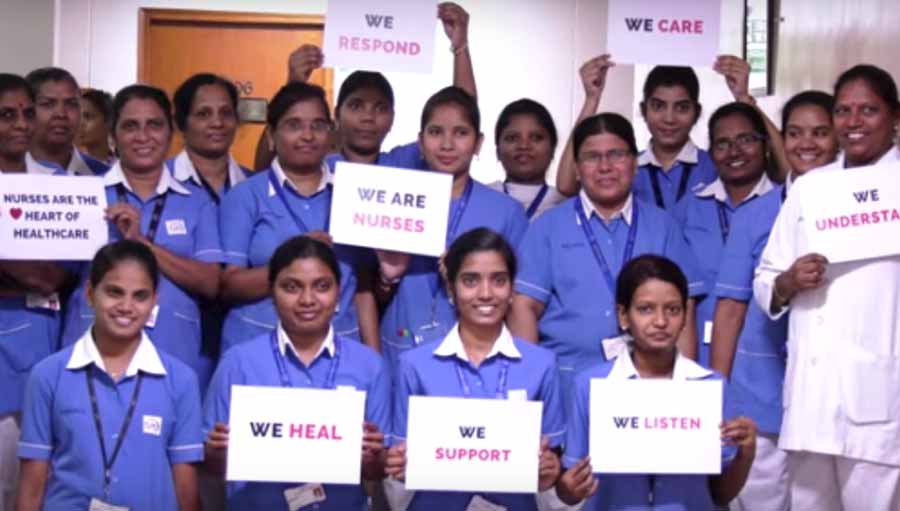Join a powerful, unprecedented alliance for better eye health for all.
Join IAPB-
Choose an alternate language here
 Shobha Mocherla, Sreedevi Yadavalli, Chaitanya Nelluri on the difference Ophthalmic Nursing Assistants–a new cadre–are making.
Shobha Mocherla, Sreedevi Yadavalli, Chaitanya Nelluri on the difference Ophthalmic Nursing Assistants–a new cadre–are making.
The Ophthalmic Nursing Assistant (ONA) is a relatively new cadre of human resources for eye care service delivery. They build capacity based on the concept of “task shifting” advocated by the World Health Organization (‘Working Together for Health’ Report 2006). The ONA is a health worker. Despite fewer qualifications and a shorter training period, they shoulder some eye nursing responsibilities and assist nurses. This allows for a more equitable distribution of eye health care work.
The L V Prasad Eye Institute (LVPEI) offers a certified vocational course for ONAs. The course mainly caters to young, rural or tribal women who study up to Grade 10. In the course, they are tutored in the theory of human anatomy and physiology and the praxis of humanistic nurse-patient communication. They also have rotations in the outpatient clinic, operation theatre, admission and discharge office, and the inpatient wards. In two years’ time, the youngsters are ready to begin a career as ophthalmic nurses.
Since the course’s inception, LVPEI has trained and certified about 500 students for the ONA clinical support certification. The ONA certification is part of a Mid-Level Ophthalmic Personnel (MLOP) training programme for economically underprivileged youth, who get to work on a modern eye care setting. An international collaboration with the School of Nursing of the University of Rochester, New York, USA, has further strengthened the ONA programme, and now, 40 students graduate every year in two batches.
Ms Phoolmani Baraik (ONA Class of 2016) is a shining example of the difference the course is making. Her family—like millions of tribal families in Central, Eastern and Southern India–was badly affected by extremist violence. But now she has a vocation and a productive future ahead.
As part of the course, nurse tutors help each student to take on responsibilities in patient care. As part of their curriculum, the trainees learn to explain medication details to patients and attendants, escort them during the hospital visit or accompany them on the day of their eye surgery. The trainees are taught:
Students listen to engrossing stories of nurses from around the world making a difference. Together with hands-on training in chair-side and bed-side patient care essentials, the trainees soon become observant and sharp learners. Such shared, active patient care makes for a more rigorous monitoring of eye medication, treatment and surgical regimens.
The ONA cadre is the result of organisational and individual efforts to bestow educational opportunities on the less-privileged sections of our society (Khanna, Marmamula, Rao, 2017). Well-trained ONAs are integral human resources at the secondary and tertiary eye centres. Simultaneously, facilitating female literacy has had a ripple effect with far-reaching implications for social justice engendered in the Alma Ata Declaration (Bhutta, Atun, Ladher, Abbasi, 2018). We deem it a matter of great pride that LVPEI has offered an educational platform for these vulnerable women to lead a full life, on a mission to make a mark with their newly-developed vocational expertise (Garg, Reddy, Nelluri, 2014).
On this day, we celebrate caring by nursing, we shout out “Long live ONAs!”
LVPEI salutes its Nurses and wishes them Happy Nurses’ Day!
Bhutta ZA, Atun R, Ladher N, Abbasi K. Alma Ata and primary healthcare: back to the future. Editorial, BMJ 2018;363:k4433
Garg P, Reddy S, Nelluri C. Training the eye care team: Principles and practice, The Middle East African Journal of Ophthalmology (MEAJO), 2014, 21:2, 128-133.
DOI: 10.4103/0974-9233.129757
Khanna RC, Marmamula S, Rao GN. International Vision Care: Issues and Approaches. Annual Review of Vision Science, 2017, 3:1, 53-68. https://doi.org/10.1146/annurev-vision-102016-061407
World Health Organization (2006). The World Health Report: ‘Working Together for Health’.
https://www.who.int/whr/2006/whr06_en.pdf